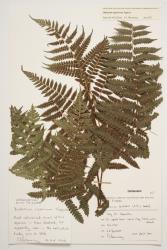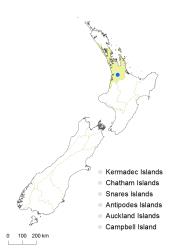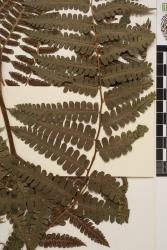- ≡ Allantodia nipponica (Tagawa) Ching, Acta Phytotax. Sin. 9: 56 (1964)
- ≡ Athyrium nipponicolum Ohwi, Bull. Natl. Sci. Mus., Tokyo, n.s. 3: 100 (1956) nom. nov. pro Diplazium nipponicum Tagawa 1933 (non Athyrium nipponicum (Mett.) Hance 1872)
In New Zealand Diplazium nipponicum has a creeping rhizome with fertile fronds 430–1000 mm long; green or yellow-brown stipes 120–370 mm long, becoming blackish proximally; laminae 2-pinnate to deeply 2-pinnate-pinnatifid, broadly ovate, 270–650 mm long and 175–600 mm wide; the longest primary pinnae ovate,140–380 mm long, 60–140 mm wide, with a short pinnatifid terminal segment tapering to an acuminate apex; secondary pinnae up to 75 mm long, 18 mm wide; tertiary segments oblong, 8–11 mm long, 4–5 mm wide, with truncate or rounded apices, margins entire or shallowly toothed, all of similar size; veins free; abaxial lamina surface bearing scattered pale brown linear scales. Indusia elongated, margins laciniate or toothed.
North Island: Auckland.
Altitudinal range: c. 40 m.
Known from one locality in Hamilton.
Occurs naturally in China and Japan.
Recorded growing on waste land on a damp clay bank under Salix species. Also known to be cultivated in Auckland and Kerikeri, where it is capable of spreading.
New record. Voucher WELT P010256, 1979.
Diplazium nipponicum was apparently sold in the horticultural trade before 1989 (B.S. Parris, pers. comm., 2016).






